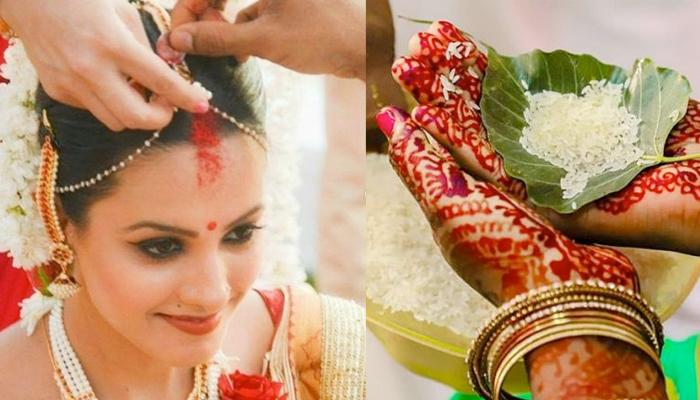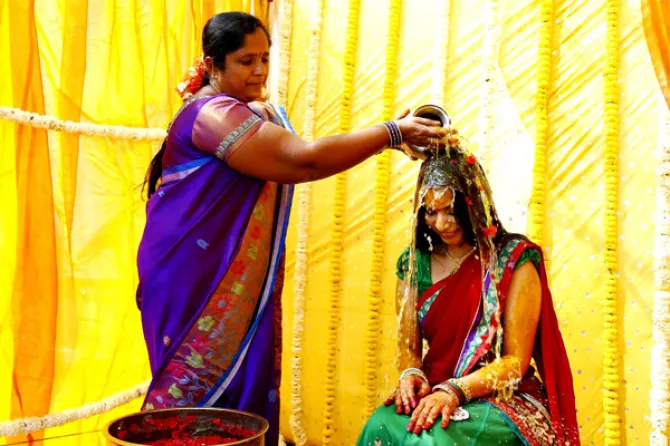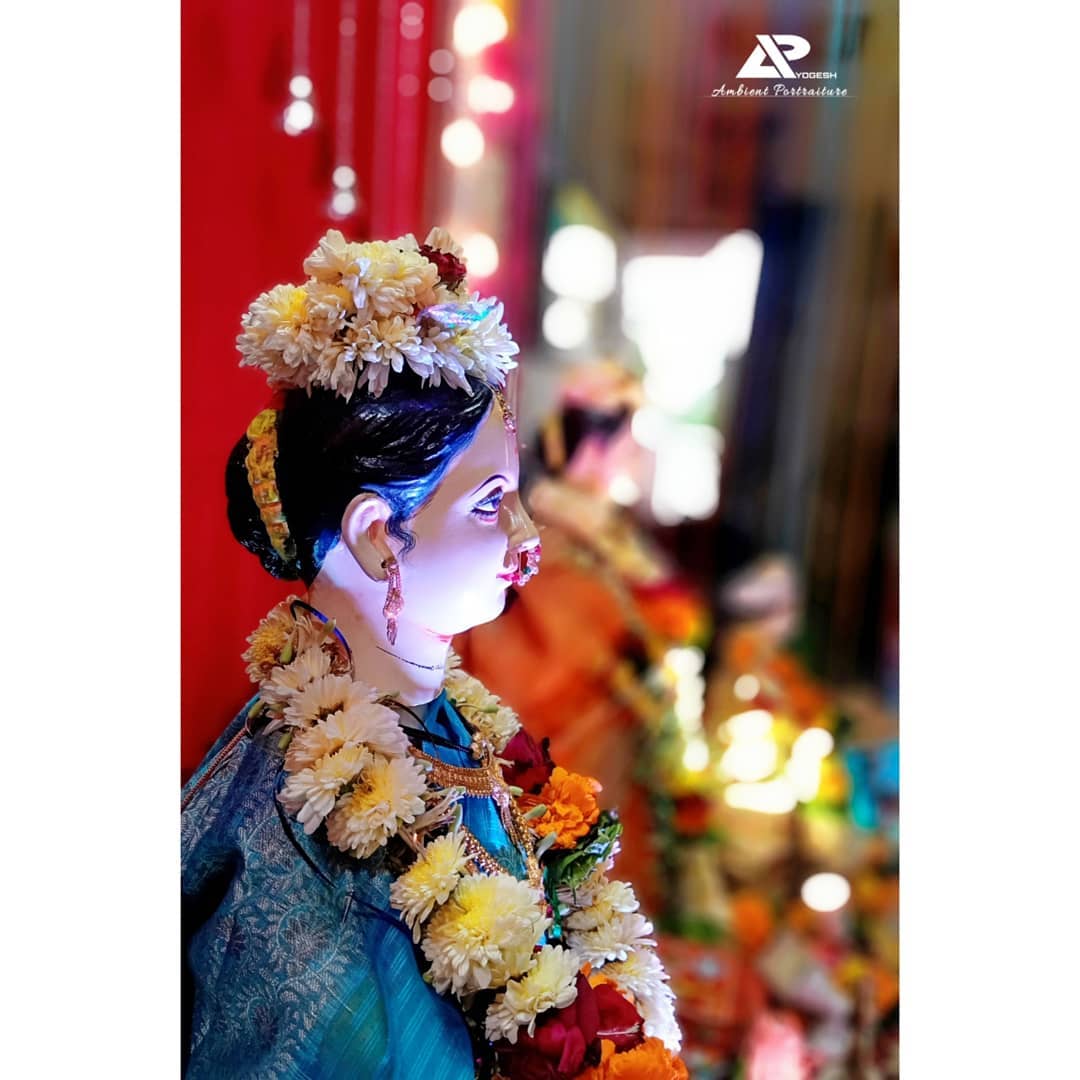About Us
Advertise With Us
RSS Feed | Content Syndication
Terms & Conditions
Privacy Policy
Contact Us
BollywoodShaadis.com © 2025, Red Hot Web Gems (I) Pvt Ltd, All Rights Reserved.

Tamil weddings are the most fun events to be a part of and the ones who have attended any South Indian wedding would vouch for the same. Portraying purity and sensuality all over the wedding venue with nadaswaram playing in the background, Tamil weddings are so vibrant, and lively, and make perfect use of red and saffron colours to empower the richness in the venue decor. There will never be shor-sharaba, something which is customary to most Indian weddings, but their belief in ‘simplicity depicts royalty’ is quite evident during any Tamil wedding.
Also, one of the unique things that might grab everyone’s attention at a Tamil wedding would be the way Tamilians embrace gold jewellery. Moreover, the bride, who is already the center of attraction becomes even more, for she is all-decked up in gold from top to bottom. The journey of a South Indian girl from Ms to Mrs is filled with fun-filled rituals and traditions. This might have made you curious, right? Well, without further ado, let’s scroll and take a look at the Tamilian bride’s journey!

The very first ritual of a Tamil wedding is Panda Kaal Muhurtham, which marks the beginning of a wedding in the house. It is a ceremony, wherein a puja is conducted at the bride's place (separate puja is held at the groom's house), in order to seek the blessings of the Almighty. This ceremony is usually held a day prior to the D-day, and the to-be bride and groom are not supposed to see each other until vivah takes place. The Panda Kaal Muhurtham puja is basically done for a smooth, peaceful, and happy wedding.

Sumangali Prarthanai, as our sub-head clearly defines is a prayer done for the married woman. The word Sumangali means a woman who is blessed with a prosperous, happy and love-filled married life. Sumangali Prarthanai is a puja that is conducted for all married women and prayers are offered to them. Afterwards, the bride-to-be takes blessings from them for her own journey towards being a missus, and also gives them a token of love in the form of a gift. In this ceremony, it is mandatory for all the Sumangalis to wear a traditional nine-yards saree or Madisar. In addition to this, only odd number of married ladies are invited for this puja be it 3, 5, 7 or 9. In the end of it, the Sumangalis are treated with lip-smacking South Indian meals, served to them specifically on a banana leaf, which is a tradition down South.

Pallikai Thellichal is yet another ceremony that is dedicated to the South Indian brides-to-be. In this ceremony, earthenware pots are adorned with vermillion as well as sandalwood paste by either 5 or 7 married women from the family or even friends. In each of the pots, nine varied types of grains or navadhaanyam mixed with curd are added along with water until the grains sprout. A day after the wedding, these pots are immersed into the water in order to feed the fish, which is considered very auspicious for the married life of the bride-to-be. Also, a Kolam or some traditional sand art designs are done at a special spot within the house, which is believed to bring good luck.

Next comes the ritual of Naandi Shrardham, wherein the family of the bride takes blessings from their ancestors by paying them homage. In this ceremony, over 10 Brahmins are invited over for a South Indian feast. All the Brahmins are given coconut, fruits, flowers, paan supari, sweets and veshti angavastram (traditional clothes). And finally, they are requested to bless the bride-to-be for her future married life.

Vrutham is the ritual that takes place at both bride and groom's houses. Talking specifically of the bride's side, it takes place early in the morning on the day of the wedding. This is a puja that symbolises the transition of a bride from her singlehood to a garhasthaya jeevan. During this ceremony, a sacred thread, which usually is coloured with turmeric is tied around the bride's wrist. This practice is said to protect the bride from the evil and ward off the negativity that might prevail. In some cases, the ceremony also involves the naamkaran, wherein the bride gets renamed.

Continue reading below
Nichayathartham is the ritual where the rings are exchanged and this begins with a Ganesh puja performed by the family of the bride. After the puja, her in-laws shower her with a new saree, jewellery and gifts. Later, when the bride wears the saree given by her in-laws, her sister-in-law, applies kumkum and chandan tilak on her forehead. And then, she is offered a garland of flowers by her nanad. Then the Sumangalis from both sides come and fill up the free end of the bride’s saree with rice, fruits, coconut, flower, turmeric, betel nut and betel leaves. Finally, the couple then exchange rings in front of their friends and families, thereby, formalising their union. In the end, the pandit reads out the Lagna Pathirigai (the invitation card) and formally announces the wedding.

Begins at the crack of the dawn, Mangala Snaanam is a ritual that is performed at both, the bride and the groom’s place, separately. This is also a ritual, which is performed by the Sumangalis or married women, who prepare a paste of sandalwood, kumkum and turmeric. One by one, the ladies apply oil in the bride’s hair and massage the prepared paste on her face, hands and feet. After this is performed by all the ladies, the bride takes a purifying bath in the holy water in order to cleanse her body and soul. And after that, she proceeds to get ready for the big day.

This is the only one ritual in the Tamil weddings, which is performed by the bride herself. It is also to be noted here that the Gauri puja is done by the bride on the very day of her wedding. After the bride gets ready, she is required to pay offerings to Goddess Gauri, who is considered as the emblem of purity, virtue and austerity. In this puja, the idol of Goddess Gauri is placed on a plate containing rice and kumkum, and the bride wishes for her happy married life.

Oonjal is a word that means swing, and during this ritual, the bride along with the groom sits on a jhoola, which is gently rocked. Again, in this ritual, the married ladies of the family offer some milk, banana, honey and sugar to the bride and the groom and bless them, whilst the woman of the family surrounds the jhoola and sing, Oonjal Pattu songs. Women from both the groom's side as well as the bride's side carry coloured rice balls along with them. They take rounds around the couple three time each, in both clockwise and anticlockwise directions. And then, the rice balls are thrown in four cardinal directions to ward off evil energy. Also, the older women of the families too take pheras in a clockwise direction three times, around the couple, holding an earthen lamp and a pot filled with water. It is also to be mentioned here that the gently rocking of the swing is the representation of the turbulent situation that life may present to them.

Kanyadaanam is a ritual that is somehow like that of the kanyadan ceremony that takes place in the north weddings. Similar to that, here too, the father of the bride hands over his daughter to the groom and his family. And, the groom gives assurance to her parents that he will take care of the bride always. One heartwarming ritual is when the bride sits on her father's lap when he is giving away his daughter. This ritual symbolises a father is giving his baby daughter who played in his lap, and seeking the groom's promise that he will always take care of her. During the Tamil wedding's kanyadaan ceremony, the bride is asked to sit on her father's lap, who is sitting facing the groom. The bride, in this ritual, holds a coconut in her hands. Then, the bride's father gives her hand into the hands of the groom and requests him to take care of her for the rest of their lives. All throughout the kanyadanam, the pandit keeps chanting the related mantras. In the end, a sacred thread is tied to the bride and the groom's hands to seal their union.

Post the kanyadaanam ceremony, Muhurtham ritual takes place. In this tradition, the bride is showered with a nine yards silk saree by the groom’s family, which is the representation of their acceptance into their family. The saree is placed around the bride’s shoulder and that’s when the groom applies sindoor/kumkum on her hair parting. The bride then changes and wears the nine yards gifted to her by in-laws. And when she returns to the mandap, a grass ring is placed on her head, atop which a yoke of the plough is placed. Also, the belt made up of a reed grass is placed around her waist. The water is sprinkled over the yoke, which is symbolic to overcome the upcoming challenges that she and the grooms might have to face. After this, the groom ties a Thaali (which is a South Indian equivalent of a mangalsutra) around her neck. The first two knots of the mangalsutra is executed by the groom and the third and the final one is done by her sister-in-law.

Satpadi means the seven sacred rounds around the holy fire, just like the saat phere in a Hindu wedding. The bride and the groom hold each other's hands and take seven rounds around the pious fire, promising to stand by each other's side and take care of one another. And the priest, alongside, chants the Vedic mantras, which outlines the seven wedding vows. This ceremony marks as the beginning of their couple life. After this, there is another ritual performed, in which the groom holds bride's left toe and helps her to tread on a grindstone, which is kept near the holy fire. This is a ritual that represents the rock-solid union of the couple as husband and wife.

Sammandhi Maryathai is the first post-wedding ritual, when a bride finally bids adieu to her family and leaves for her new house with her husband. During this ritual, both the families exchange gifts as a token of appreciation after praying to her family deity.

Grihapravesham is the time when the newbie bride makes an entry into her new home which is her husband's house. At the entry of the house, bride's mother-in-law offers prayers and execute an aarti, in order to welcome the couple, especially her daughter-in-law.

Valeyadal is a ceremony in which the bride's sister-in-law gifts her newbie bhabhi a meaningful present, probably some gold. Then, she helps in planning some fun post-wedding games for the newlywed couple. In some Tamilian communities, this ritual is called, Nalanga and takes place right after the wedding ceremony.
All-in-all, these are some of the specific rites and rituals that are a part of a Tamilian bride's journey from Ms to Mrs. Though the rituals might not be that extravagant like that of North Indian weddings, but the royality in their simplicity is what is being applauded by many. Hasn't this urged you to attend a South wedding straightaway? Raise your hands if your answer is in affirmative!
advertisement
advertisement
advertisement
